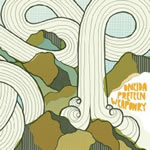|
|
 |
Dusted Reviews
Artist: Oneida Album: Preteen Weaponry Label: Jagjaguwar Review date: Jul. 28, 2008 |

|
|
|
 |
Click your way through Dusted’s collected takes on Oneida at the bottom of this page and you’ll see one word over and over again – prog. The Brooklyn-based trio’s previous releases have betrayed their affection for twisty, turny, synth-infused prog rock, especially the sort that originated in a certain European country that used to have a weak currency. But they’ve balanced such proclivities with stabs at Ozzy-esque wheeze-rock, Simon and Garfunkle-style folk-rock, and quarter-hour-long one-riff sludge-fests.
On Preteen Weaponry, they forgo balance and discipline in favor of rampant monomania. It’s a one-song album that foreshadows an upcoming triple album; together they comprise two-thirds of a trilogy called Thank Your Parents, which the eagle-eyed will note is already the name of the last song on their last album, Happy New Year. Self-referentiality and untrammeled ambition – clearly Oneida have let loose the dogs of prog.
But if Preteen Weaponry initiates a trilogy, maybe it’s really Oneida’s The Fellowship of the Ring; they do spend a lot of time trundling around only to leave you hanging. The song “Preteen Weaponry” is split into three parts, each between 11 and 14 minutes long, and each part is devoted to an instrumental theme that gets run into the ground. Not that that’s automatically a bad thing. Oneida’s Kid Millions, Hanoi Jane and Bobby Matador enjoy the sort of chemistry that can make the song they’re playing almost irrelevant. The fun is in the way they grab hold of a groove and ride it hard, ratcheting up the tension until it’s almost unbearable.
“Part 1” never gets that intense, even though it works variations on a four-note figure with the remorseless single-mindedness of an old train-spotter ticking off his favorite engines as they roll out of the Burlington Northern yard. Keyboard textures swirl around the edges like blue exhaust, palpable yet ephemeral. “Part 2” is more ponderous. It takes an older Oneida melody, “History’s Great Navigators,” and weighs it down with throbbing bass and orbiting wah-wah licks so that it lumbers like a stoned bison. This is the only spot where the band breaks into song, chanting for a moment over a processional drum tattoo before a blast of electric noise melts the song down like a volcanic blast turning a glacier into a mudslide; it’s cool to behold, but the slog it took to get there is pretty fatiguing.
Trudging gives way to sprinting in the final third. This is where the band finally locks into the sort of jam that they do so well, reining in the riff while saving room for a steady stream of sound effects and organ burps. They keep floating for a second after the drums drop out, like a cartoon coyote who has not yet noticed the canyon yawning beneath its airborne feet. Then it’s over. “Part 3” points out what’s wrong with the rest of this record. Oneida’s chemistry alone isn’t enough to make modest material effloresce.
By Bill Meyer
|







